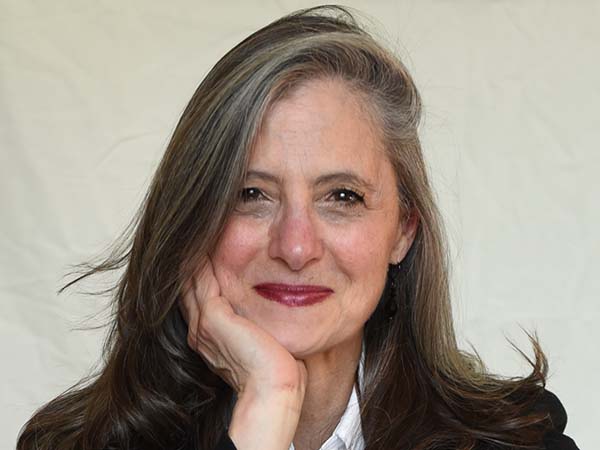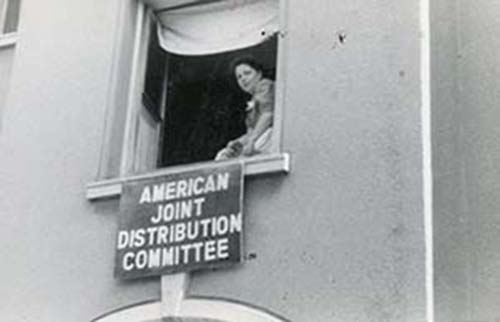
New Book—From Left to Right: Lucy S. Dawidowicz, the New York Intellectuals, and the Politics of Jewish History
A transnational American Jew with a Polish Jewish soul
Nancy Sinkoff’s book From Left to Right: Lucy S. Dawidowicz, the New York Intellectuals, and the Politics of Jewish History is a thought-provoking intellectual biography of Lucy (Schildkret) Dawidowicz, a pioneer historian of the Holocaust, and an influential figure of postwar American Jewish public life, who worked for JDC in postwar Germany.
Dr. Sinkoff, the academic director of the Allen and Joan Bildner Center for the Study of Jewish Life and Professor of Jewish studies and history at Rutgers University, examines Dawidowicz’s political evolution from left to right. The child of Eastern European Jewish immigrants, Dawidowicz grew up in a Yiddish-speaking socialist home. She flirted with communism as a college student at Hunter, became a Democrat in the 1930s, and then was an anti-communist liberal until the mid-1960s. Like other New York intellectuals, her relationship to liberalism was challenged by the social, cultural, and political turmoil of the 1960s, and by the end of her life, she was a neo-conservative.
The first half of the book, which chronicles Dawidowicz’s youth and her formative years in Europe and New York, is particularly relevant to those interested in the cultural ties between American and European Jews in the immediate prewar and postwar period. It narrates how in her childhood and adolescence, Dawidowicz inhabited two environments -the American one of the New York City public school system and the immigrant one of the Yiddish afternoon school. Dr. Sinkoff points out that this “shaped her hyphenated identity as an American Jew and an East European immigrant daughter.”
Unemployed after graduating from Hunter College, Dawidowicz threw herself into the activities of the Sholem Alecheim Youth Organization and immersed herself in Yiddish culture. In 1938, she set out for Vilna, Poland, to study at YIVO’s graduate program. Dr. Sinkoff notes that the year she spent in Vilna in an ominous and antisemitic climate and her flight through Nazi Germany in August 1939 helped transform Dawidowicz into a “transnational American Jew with a Polish Jewish soul.” Back in the United States, Dawidowicz began working as a secretary at the American branch of YIVO, where she was involved with the early scholarly efforts to analyze anti-Jewish violence and persecution under German occupation.
In 1946, Lucy left YIVO and returned to Europe as an education worker for the JDC. She worked at the Offenbach Archival Depot (OAD)—the repository for printed material pillaged by the Germans—as the JDC representative authorized to select books for distribution to DPs. While working at OAD, she became responsible for cataloging the books which she recognized as belonging to YIVO and ensuring their shipment to YIVO in New York City. The recovery of YIVO’s library was historically significant and helped to establish YIVO in New York as a critical institutional link to the East European Jewish past.
In 1947, Dawidowicz transferred to the Belsen DP camp in the British zone, where she continued to work for the JDC, providing educational material and supplies to the DPs and initiating cultural and recreational programs.
While in British-occupied Germany, Dawidowicz, found herself in the middle of the drama surrounding the disembarkation of refugees from the SS Exodus. In the summer of 1947, 4,500 Jewish refugees sailed from France to Palestine on board the Exodus. The British authorities did not allow the ship to dock in Palestine. After a battle between British naval forces and the passengers, which led to the death of three passengers and the injuring of ten others, the refugees were sent back to France. They refused to disembark, and after a stalemate, they eventually sailed for Hamburg, under British rule. Lucy was dispatched with other JDC staff members to provide assistance to the refugees. The Joint sent doctors and provided food, clothing, religious items, and books to the refugees. Sinkoff notes that her fifteen months in postwar Europe affected Dawidowicz deeply and strengthened her commitment to Jewish people.
In 1949, Dawidowicz began working for the American Jewish Committee (AJC) research services department. While there, she wrote about a wide range of topics: communism, the role of religions in American public life and the relations between the Jewish and African-American communities. While working at the AJC, Lucy completed her master’s degree at Columbia University. She wrote her thesis on Louis Marshall, a founder of the JDC and a key figure in the Jewish community of the early twentieth century.
In 1967, Dawidowicz published The Golden Tradition: The Jewish Experience in Eastern Europe, an anthology of primary sources translated from Russian, Polish, Yiddish, German, and Hebrew, representing the diversity of Jewish life in Eastern Europe. The book was acclaimed and gave her authority as a scholar. She was hired by Yeshiva University, where she developed the first university course on the history of the Holocaust. She quickly became aware of the scarcity of books in English on many aspects of the Holocaust, a realization which prompted her to publish her seminal work, The War Against the Jews, in 1975, a popular history of the Holocaust and the Jewish response to it. The book’s central argument was that Hitler’s assault on Europe was focused on the destruction of the Jews, who responded with dignity to the virulent antisemitism. By claiming that Adolf Hitler’s anti-Semitism was the driving force behind the Holocaust, Dawidowicz became the leading representative of the “intentionalist” school of Holocaust historiography at odds with the “functionalist” historians, such as Raul Hilberg, who argued that the Final Solution was the evolutionary product of competing Nazi bureaucracies rather than of Hitler.
After the publication of The War Against the Jews, Dawidowicz went on to publish two other books related to the Holocaust, A Holocaust Reader (1976) and The Holocaust and the Historians (1981), which, as Dr. Sinkoff points out, became key texts in shaping Holocaust consciousness among American Jews.
Along with Eli Wiesel, Dawidowicz became one of the most sought-after lecturers about the Holocaust. Despite her contribution to Holocaust historiography, she has been somewhat forgotten by the public. A very engaging read, From Left to Right manages to rescue her from oblivion.





